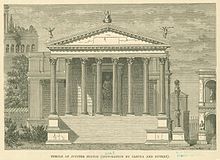Temple of Jupiter Stator (3rd century BC)

The Temple of Jupiter Stator (Jupiter the Stayer) was a temple of ancient Rome, located in the area of the Roman Forum.
History
The temple was first founded by Romulus after a battle in the Forum area between Romulus and the Sabines. During that battle the Romans were forced to retreat up hill on the Via Sacra. However, at the Porta Mugonia, Romulus prayed to Jupiter, vowing him a temple should he stem the Sabine advance. The Romans managed to regroup and hold their ground against the Sabines, who were eventually defeated.
On that spot Romulus founded the temple, probably near or just outside the Porta. This sanctuary was most likely not an aedes but only an altar enclosed by a low wall or fence.
In 294 BC Marcus Atilius Regulus made a similar vow in a similar situation, when the Romans were losing a battle against the Samnites, but then miraculously turned around, regrouped and held their ground against the enemy.
On November 8, 63 BC, it was in this temple that the senate convened to hear the consul M. Tullius Cicero deliver his famous first oration against Catiline.
The temple was destroyed in the Great Fire of Rome during Nero's reign in July of the year 64.
Location
Since the Porta's site is not known, the temple's location is not known with absolute certainty. The written sources give some hints, such as near or just outside the Porta, on the higher end of the Via Sacra or just on the Palatine Hill, the site of Romulus's Rome.
Livy states that the temple was located near the royal palace at the time of the death of Lucius Tarquinius Priscus, near the "new street" (nova via) and that queen Tanaquil addressed the people from the palace window.[1]
There is a fair amount of consensus on a location just besides the Arch of Titus on the N. slope of the Palatine Hill. When a medieval tower was demolished in 1827, the ruins of an ancient building appeared, and these remains are frequently identified as the foundations of this temple.
The Italian archaeologist Filippo Coarelli places it closer to the forum, between the Temple of Antoninus and Faustina and the Basilica of Maxentius, where the Temple of Romulus stands. His line of reasoning is based on the course of the Via Sacra before the construction of the Basilica of Maxentius, the known borders of the ancient administrative regions of the city and literary sources listing the monuments in each region. The location near the Arch of Titus does not fit, since it is in the wrong administrative region and not in the right position relative to the other buildings listed by ancient writers, but the Temple of Romulus on the Via Sacra is a perfect match.
References
- ^ Livy, Ab urbe condita, 1.41
